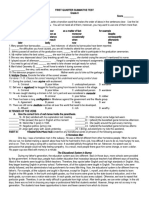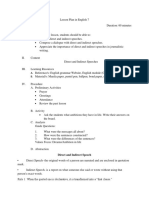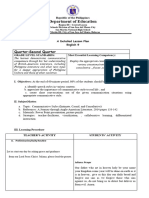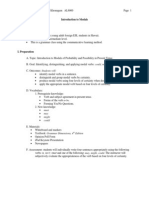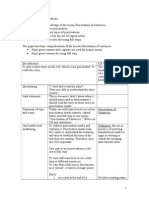I-Unit A Reading-Peace and Hormony
I-Unit A Reading-Peace and Hormony
Uploaded by
Meeseva KondurgCopyright:
Available Formats
I-Unit A Reading-Peace and Hormony
I-Unit A Reading-Peace and Hormony
Uploaded by
Meeseva KondurgOriginal Description:
Original Title
Copyright
Available Formats
Share this document
Did you find this document useful?
Is this content inappropriate?
Copyright:
Available Formats
I-Unit A Reading-Peace and Hormony
I-Unit A Reading-Peace and Hormony
Uploaded by
Meeseva KondurgCopyright:
Available Formats
1 Peace and Harmony
Look at the picture and discuss the questions that follow:
1. What does this picture tell you about the animals?
2. Are they happy or unhappy? How do you know?
A. Reading
Read the following story and answer the questions that follow:
Once upon a time, in a very thick forest there lived many animals, birds, snakes and
insects. They all lived together happily. They roamed about the jungle, and played together
in the open fields without any fear. The peacocks were very proud of their dances but admired
the melodious songs of the cuckoos. The elephants enjoyed watching the fish swimming in
the pool. The pythons which were blessed with long bodies, spoke well of the fine fur of
the flat-footed rabbits. The tiny ants, which were always busy, tickled the dark buffaloes.
Free distribution by T.S. Government 1
They often held musical evenings in a large open field. The elephant and the deer
danced. The mynahs and the parrots sang. The tiger and the bear exhibited gymnastics. They
called the moon and his friends, the stars, to be the guests of honour at their musical evenings.
One day a jackal entered the forest. He was dirty, dangerous, and very cunning too. He
told the elephants, “You are the biggest animals in the forest. Why do you want to play with
the squirrels and the rabbits?” He poisoned the minds of the peacocks saying, “You are the
loveliest birds in the forest. Why do you want to praise the mynahs?” The jackal then
approached the deer and whispered that the tiger was waiting for a chance to kill them.
Gradually, all the animals began suspecting one another. Earlier they had lived together,
slept together and roamed around the forest together. Now they started to put up boundaries
and build fences around their properties. They moved about individually or with their own
group.
Now it was easy for the jackal to hunt the smaller animals and the birds. And when the
smaller ones cried out for help, no one came to help them. One by one, the little ones
disappeared. The forest slept as the animals were afraid. There were no more musical
evenings. The moon was sad. He cried.
The moon thought for a while and decided to come down among the animals and the
birds as a sadhu. As soon as the sadhu appeared in the forest, the animals and the birds
approached him to narrate their tales of woe. They cried, sobbed and blamed each other for
disturbing the peace in the forest. And the sadhu listened to them.
2 Free distribution by T.S. Government
The sadhu brought together the lions and the rabbits for a common meal. He visited
the python and the viper, and had a long chat with them. He advised the eagle not to attack
the little chicks that had lost their mother. The sadhu accompanied the tiger and the wild
bear to the nearest market. He played with the bulbul, the owl and the monkeys.
But the jackal was very angry with what the sadhu was doing. He did not want the
animals to live in peace and harmony. So he was waiting for an opportunity to attack the
sadhu.
One day, the animals, insects and birds held an emergency meeting and they
unanimously decided to approach the sadhu and pleaded with him to kill the jackal. The
sadhu said, “I will not kill the jackal but help you in a different way.”
When the sun went to sleep, the jackal came to the house of the hens to take a few of
them for his supper. The sadhu, who had been lodging nearby, came out of the house and
spoke to the jackal. “Take me today for your meal.”
The jackal who had been waiting for this opportunity, dragged the sadhu and ran into
the jungle. He took the sadhu to a lonely place, tore him into pieces and ate him up. The
animals were very sad, angry and disappointed with what had happened to the sadhu. They
were afraid that the hungry jackal would appear again the next day. Then they heard a strange
noise. All of them ran in that direction. What they saw surprised them. They saw the stomach
of the jackal growing bigger and bigger. It continued to bloat until it burst. Then they heard
a soft voice: “May my animals, birds and insects live in peace and harmony! May there be
no fences around you! May you sing and dance once again! Remember me and be not afraid.”
When they looked up at the sky, they saw the moon shining brilliantly, spreading
milky brightness over the earth. The animals once again started to roam, sing, and sleep in
peace. They broke down the fences which they had built. They invited the moon and the
stars for their cultural evenings.
Glossary\
gymnastics (n) : physical exercises
property (n) : objects or things owned by somebody
woe (n) : extreme sadness
harmony (n) : a state of living together peacefully
unanimously (adv) : unitedly
bloat (v) : become bigger and bigger (swell unpleasantly)
Free distribution by T.S. Government 3
How well did I read?
Fill in the boxes using yes/ somewhat/ no.
I enjoyed reading the passage.
I got the idea of the passage on my own.
I got the idea with the help of my friends in the group.
The teacher helped me to understand the passage.
I used the glossary given at the end of the passage.
I. Answer the following questions:
1. How were the animals before the jackal joined them? Pick out the words which
describe their mood.
2. What happened to the animals after the jackal came to the forest?
3. What was the jackal’s plan? How did it succeed?
4. What did the animals do to check the jackal’s evil design?
5. How was the moon disguised? Why did he choose that form?
*6. Why did the sadhu ask the jackal to take him for his meal? Would you do the
same if you were in his place?
7. What did the sadhu teach the animals in the forest?
*8. Do you think the sadhu sacrificed his life for the sake of animals in the forest?
Give reasons for your answer.
II. Read the following paragraph and analyse it in terms of cause and effect /
consequence. One has been done for you.
The animals in the forest were friendly, so the jackal could not eat any animal. The
jackal then thought of a plan and implemented it. The animals started suspecting each other
as the jackal’s plan worked. The life in the forest became dull because there were no
musical evenings. All the animals requested the sadhu for help, so he talked to the animals
and the birds and solved their problem. However, the sadhu didn’t want to kill the jackal,
but preferred to teach a lesson to it.
Cause Consequence
All the animals in the forest were friendly. The jackal couldn’t eat any animal.
4 Free distribution by T.S. Government
III. Rearrange the following sentences in the order of their occurrence in the story.
Then rewrite them into a meaningful coherent paragraph using appropriate
linkers.
1. The animals and the birds requested the moon to help them.
2. The moon came in the form of a sadhu.
3. The jackal created an unfriendly atmosphere.
4. The peace and harmony in the forest was disturbed.
5. The jackal entered the forest.
6. The peace and harmony in the forest was restored.
7. The jackal did not like this, so it killed the sadhu.
8. The sadhu talked to everyone in the forest and tried to restore peace.
9. They often held musical evenings.
10. The animals and the birds began suspecting each other.
11. The animals and the birds were living happily together.
12. The stomach of the jackal bloated and then burst.
Here is the first sentence: The animals and the birds were living happily together.
Vocabulary
I. Read the following sentences from the story:
They heard a soft voice.
He was dirty and dangerous.
It was easy for the jackal to hunt the smaller animals and birds.
The jackal told the elephant, “You are the biggest animal in the forest.”
He said to the peacock, “You are the loveliest bird in the forest.”
The underlined words are called Adjectives.
1. They come either before or after a noun ( a tall boy )
2. They take intensifiers like very, quite (a very tall boy)
They have degrees of comparison - Positive, Comparative and Superlative.
Here are the three forms of some adjectives.
Positive Comparative Superlative
dark darker darkest
small smaller smallest
near nearer nearest
big bigger biggest
lovely lovelier loveliest
dirty dirtier dirtiest
melodious more melodious most melodious
Free distribution by T.S. Government 5
Read the following paragraph carefully, underline all adjectives and write
the other degrees of comparison for them.
Yesterday we went for a picnic to Nehru Zoological Park which is one of the biggest
zoos in the country. The climate was cool and pleasant. We saw many animals, birds, reptiles
etc. We also saw a very large elephant. After that, we saw a tall giraffe with a long neck.
There were also some small birds which sang sweet songs. There was a beautiful peacock
which danced majestically. We went very close to the brown cobra. We felt very happy. We
reached home late in the evening
II. Read the following words. Each pair has one word and the other word is its
opposite in meaning:
big X small near X far
dark X light open X close
happy X unhappy start X stop
large X small thick X thin
live X die appear X disappear
long X short common X uncommon
Now fill in the blanks in the sentences given below with the word opposite in
meaning to the one in bold letters.
1. The elephant’s eyes are small but its body is ————————————
2. The animals were happy in the beginning. After the jackal entered the forest,
they became ————————
3. The giraffe’s neck is very long but its tail is —————————
4. Mangoes are sweet but lemons are ——————————————
5. The coconut is a tall tree but the guava is a ——————— tree.
III. The following pairs of words are similar in meaning. Pick out such pairs
from the story you have just read.
animals – creatures small – tiny
build – construct talk – speak
large – big, huge
6 Free distribution by T.S. Government
Grammar
I. Read the following sentences.
The elephant is bigger than the donkey.
The donkey is not so big as the elephant.
In the above sentences the elephant and the donkey are compared with respect to
their size. The words “big” and “bigger” are adjectives that are used to compare their
size.
Here is some information about a group of pupils in 6th class.
Name of the Student Age in Years Height in Ft. Weight in Kgs.
Harini 11 4.9 27
Seshagiri 12 5.1 30
Akhila 12 4.8 28
Bhaskar Raju 10 4.5 24
Siddu 13 5.3 35
Rajesh 11 5.1 28
Raghava 12 4.9 28
Vamsi 13 4.5 27
Manoj 12 5.1 30
Gopi 10 4.5 25
Now make 20 sentences comparing the ages, heights and weights of the students
as shown in the examples given below:
Harini is as tall as Raghava.
Harini is not so heavy as Raghava.
Harini is older than Gopi.
Siddu is the heaviest boy in the group.
II. Look at the following sentences paying special attention to the underlined
words.
The tiny ants, which were always busy, tickled the dark buffaloes.
They often held musical evenings in a large open field.
The underlined words are adverbs, which tell us how often something happens.
They are called adverbs of frequency.
Free distribution by T.S. Government 7
Read the following passage and underline the adverbs of frequency.
Sekhar is a busy taxi driver. He never finds time to read books. He often takes food
outside. He reaches home early in the evening. But he seldom goes to bed early. So, his
children always ask him for a bed time story. Sometimes he takes his children for picnics
and buys toys and gifts.
Look at the conversation between two friends, Murthy and Krishna. Fill in the
blanks with always, never, often, seldom, sometimes.
Murthy : Do you like to watch films?
Krishna : Yes, very much. I —————— watch films, a film a day. How about
you?
Murthy : I like films too. But I ——————watch films, not always.
Krishna : How ——————— do you watch films?
Murthy : Once or twice a month.
Krishna : Oh, that’s fine. Have you watched Sri Ramarajyam?
Murthy : No, I haven’t. I’ll watch it next month. How ________does your
wife watch films?
Krishna : She ______ watches films. She watched one 10 years ago.
Writing
I. Here is an invitation card from the animals about a musical programme in the
forest. Read it carefully.
GEGGEGGEGGEGGEGGEGGGEGGEEGEGGGEGGGEGGEG
Invitation - Musical Programme
Venue : Greenwood Forest
Date & Time:
Guests of honour : 1) Moon 2) Stars 9th Aug. 6 pm onwards
Welcome Address : Peacock
Cultural Programmes
1. Dance : Made for Each Other by Elephant and Deer
2. Song : Victory over the Jackal by Parrots and Mynahs
3. Gymnastics show : Health Tips for All Animals by Tiger and Deer
4. Skit : Fine Fur of Rabbit by Cuckoo and friends
5. Vote of thanks : Wild Buffalo
All are welcome.
- By Animals of the Forest
GEGGEGGEGGEGGEGGEGGGEGGEEGEGGGEGGGEGGEG
8 Free distribution by T.S. Government
Suppose you are planning to conduct a cultural programme in your school on
the occasion of your School Anniversary. Design an invitation card. You may use the
model given above.
How well did I write?
Fill in the boxes using yes/ somewhat/ no.
I was able to explain / describe / narrate well.
The sentences I used were properly connected.
I was able to express my ideas in apt words.
The ideas were arranged in proper sequence.
I used proper punctuation marks.
How well did I edit my work?
Fill in the boxes using yes/ somewhat/ no.
I deleted the excess words.
I corrected the wrong forms of words.
I corrected the punctuation errors.
I added new words wherever necessary.
I corrected the misspelt words.
II. Read below how Peacock, the organizer, compered the whole programme in
the Greenwood Forest.
Dear Mr. Moon, Stars and dear Friends,
I welcome you all to the Peace and Harmony Programme organised in the Green
wood Forest. As you’re aware, we have with us Mr Moon and Stars as our guests of honour.
On behalf of our animal kingdom, and on my behalf, I thank them for sparing some of their
valuable time for us. I’d request Mr Moon to say a few words on this occasion.
(Mr Moon says a few words)
Mr Moon sir,...............
Thank you sir, for saying very kind words for us.
Now I will begin our cultural programme with a dance item called “Made for Each
Other”. This will be presented by Elephant and Deer.
(Dance item by Elephant and Deer)
I’m sure you have liked the item. The next item in our programme is a song called
“Victory over the Jackal.” This will be sung by Parrots and Mynahs.
(A song by Parrots and Mynahs)
Free distribution by T.S. Government 9
How was the song? Did you like it? Now you will see the gymnastic show called
‘Health Tips for All Animals’. This will be presented by Tiger and Deer.
(Gymnastic show by Tiger and Deer)
I am sure you have enjoyed the show. Now you will see a skit called ‘Fine Fur of
Rabbit’. It will be presented by Cuckoo and Friends.
(Skit by Cuckoo and friends)
Now I invite the Wild Buffalo, the President of the animal kingdom to propose a vote
of thanks.
(Vote of thanks by Wild Buffalo)
Finally, I invite you all to have a mouthful of juice before you leave.
III. Imagine that you are the cultural Secretary of your school. You have been asked
to compere the programme on the school Anniversary day. Prepare your script
and then give a mock performance before your group.
Study Skills
Read the following Table of Contents of a book:
Unit No Lesson Page No.
Unit 1 : Dolphins 1
Unit 2 : Olympic Games 9
The Swing (Poem)
Unit 3 : Hovercrafts 19
Unit 4 : Vikram Sarabhai 24
Trees( Poem)
Unit 5 : Fossils 32
Unit 6 : Crocodiles 38
Four Chairs (poem)
Unit 7 : Kites 47
Unit 8 : Habits 52
Mosquito (poem)
Unit 9 : Fingerprints 62
Unit 10 : An Act of Bravery 68
I Wonder (Poem)
10 Free distribution by T.S. Government
You might also like
- CHECKED Lesson Plan On The Wise Old Woman and Misplaced ModifiersDocument12 pagesCHECKED Lesson Plan On The Wise Old Woman and Misplaced ModifiersLancy Abegail Gabrillo CastronuevoNo ratings yet
- Baco National High School: Department of EducationDocument9 pagesBaco National High School: Department of Educationangel grace mercadoNo ratings yet
- Albert Rosales The Fall of Iron Curtain and The Return of The HumanoidsDocument64 pagesAlbert Rosales The Fall of Iron Curtain and The Return of The HumanoidsJavier RuedaNo ratings yet
- Methods of Teaching EnglishDocument201 pagesMethods of Teaching EnglishMarton Roland100% (2)
- Adverb Worksheet For Grade 9Document3 pagesAdverb Worksheet For Grade 9Vince BulayogNo ratings yet
- Contractions Vs Possessive LessonDocument5 pagesContractions Vs Possessive Lessonapi-351267509No ratings yet
- Lesson Plan - Selected PoemsDocument7 pagesLesson Plan - Selected PoemsNameera AhmedNo ratings yet
- A Falling IntonationDocument1 pageA Falling IntonationRosel Gonzalo-Aquino0% (1)
- Poetic Conventions - Sound Devices WorksheetDocument6 pagesPoetic Conventions - Sound Devices WorksheetCHRISTIAN CANASNo ratings yet
- Learning Competency (Essential Competency)Document6 pagesLearning Competency (Essential Competency)Heidee BasasNo ratings yet
- The Road Not Taken - Larissa Polowick - Lesson Plan 10-1-0Document2 pagesThe Road Not Taken - Larissa Polowick - Lesson Plan 10-1-0Patricia Lorica100% (1)
- Daily Lesson PlanningDocument2 pagesDaily Lesson Planningleana0803No ratings yet
- Figures of Speech - LPDocument3 pagesFigures of Speech - LPAr Lou100% (1)
- Alliteration, Consonance, and AssonanceDocument12 pagesAlliteration, Consonance, and AssonanceMike Irish PaguintoNo ratings yet
- Lesson Plan - Big CatsDocument7 pagesLesson Plan - Big CatsjerelinNo ratings yet
- TOS English9 2ndgradingDocument3 pagesTOS English9 2ndgradingCherryDeePelayoBalilu100% (1)
- Detailed Lesson Plan English 10Document8 pagesDetailed Lesson Plan English 10Raze AdamsNo ratings yet
- Sensoryimageppt 140209014459 Phpapp01Document12 pagesSensoryimageppt 140209014459 Phpapp01Junior Payatot100% (1)
- LAS q2 English9 Week1 v2Document7 pagesLAS q2 English9 Week1 v2Devon M. MasalingNo ratings yet
- Every Summer, Every Morning, Get Up at Eight, Late Every DayDocument3 pagesEvery Summer, Every Morning, Get Up at Eight, Late Every DayDebbie Anne Sigua LicarteNo ratings yet
- Informative TextDocument16 pagesInformative TextLeslie GuarteNo ratings yet
- LP Magi (LITERATURE)Document5 pagesLP Magi (LITERATURE)Elaine Mae SolomonNo ratings yet
- Lesson Plan in English 9Document88 pagesLesson Plan in English 9Maricris RefugioNo ratings yet
- P11 PPT Scrabble GamesDocument16 pagesP11 PPT Scrabble Gamesdiktiedu5984No ratings yet
- Lesson Plan - Word FormationDocument4 pagesLesson Plan - Word FormationMarisatul Khasanah100% (1)
- Semi-Detailed Lesson Plan in English Viii I. Objectives: JULY 08,2019Document4 pagesSemi-Detailed Lesson Plan in English Viii I. Objectives: JULY 08,2019Grace AntonioNo ratings yet
- First Quarter Module 4 (English 7)Document58 pagesFirst Quarter Module 4 (English 7)RamilNo ratings yet
- Summative 8 Grade 8 English 1Document1 pageSummative 8 Grade 8 English 1Melisa ReguceraNo ratings yet
- Direct and IndirectDocument3 pagesDirect and IndirectPaul Christian Ybañez EyasNo ratings yet
- English G9 Week 1 To 7Document27 pagesEnglish G9 Week 1 To 7Kristina Calejesan100% (1)
- Matatag Learning Plan English7 First QuarterDocument21 pagesMatatag Learning Plan English7 First QuarterRicardo Acedo Jr.No ratings yet
- Cohesive Devices Exercise OdetteDocument4 pagesCohesive Devices Exercise OdetteJeanetta Jonathan100% (2)
- Reading Comprehension Anne FrankDocument16 pagesReading Comprehension Anne FrankScribdTranslationsNo ratings yet
- While The Auto Waits DLLDocument7 pagesWhile The Auto Waits DLLBilly Joe RavagoNo ratings yet
- English7 Q1 Wk5 Past-PerfectTenseDocument11 pagesEnglish7 Q1 Wk5 Past-PerfectTenseRose Ann SelomNo ratings yet
- The Ants and GrasshopperDocument15 pagesThe Ants and GrasshopperHershil SinglaNo ratings yet
- Lesson Plan DreamsDocument2 pagesLesson Plan DreamsCindy AlereNo ratings yet
- Lesson Plan Co1 Sy2022-2023Document13 pagesLesson Plan Co1 Sy2022-2023Dom Raymer IgnacioNo ratings yet
- LogicalDocument8 pagesLogicalMharlone Chopap-ingNo ratings yet
- Good MorningDocument14 pagesGood MorningGRACE ANN EDRADANNo ratings yet
- LappDocument14 pagesLappapi-301715107No ratings yet
- Lesson Plan Grade 7 EnglishDocument22 pagesLesson Plan Grade 7 EnglishJohn David Desamparo DawalNo ratings yet
- English Lesson Plan-COT 4thDocument7 pagesEnglish Lesson Plan-COT 4thRiza VillariasNo ratings yet
- Characterization Lesson PlanDocument2 pagesCharacterization Lesson PlanmicheekatNo ratings yet
- Epic and Lyric Poems Describe Two of The Most Common and WellDocument8 pagesEpic and Lyric Poems Describe Two of The Most Common and WellJonathan Japson Pastera100% (1)
- Lesson Plan in English For Teaching Demonstration (Grade 8) Context CluesDocument8 pagesLesson Plan in English For Teaching Demonstration (Grade 8) Context CluesClarisse DomagtoyNo ratings yet
- The Courage That My Mother HadDocument1 pageThe Courage That My Mother HadFran Cis CuNo ratings yet
- LP ConjunctionDocument6 pagesLP ConjunctionbansmangindalatNo ratings yet
- Introduction To ModalsDocument4 pagesIntroduction To ModalsChris KhonngamNo ratings yet
- English 7 MELC-based: Direct and Reported SpeechDocument21 pagesEnglish 7 MELC-based: Direct and Reported SpeechMikhie Shane Tolentino100% (1)
- Lesson Plan For The 9th GradeDocument3 pagesLesson Plan For The 9th GradeflorentinNo ratings yet
- Lesson Plan Grammar PunctuationDocument3 pagesLesson Plan Grammar PunctuationRosmalia KasanNo ratings yet
- Final LPDocument10 pagesFinal LPVerna HensonNo ratings yet
- A Detailed Lesson Plan For Grade 8 EngliDocument12 pagesA Detailed Lesson Plan For Grade 8 EngliHanna MikangcrzNo ratings yet
- EVALUATION Logical-ConnectorsDocument1 pageEVALUATION Logical-ConnectorsEdison B. BuenconsejoNo ratings yet
- Participle WorksheetDocument2 pagesParticiple WorksheetAnglophile123100% (1)
- Creative Composition Lesson Plan PDFDocument2 pagesCreative Composition Lesson Plan PDFapi-283943860No ratings yet
- Outlining A TextDocument6 pagesOutlining A TextJulieSanchezErsandoNo ratings yet
- Summarising PowerpointDocument13 pagesSummarising Powerpointgihan1mohamed1ahmedNo ratings yet
- Poetic Devices Lesson PlanDocument3 pagesPoetic Devices Lesson Planapi-594077974No ratings yet
- EnglishDocument10 pagesEnglishPratapareddyBogoluNo ratings yet
- Bidyut ProfileDocument10 pagesBidyut Profilebidyut dasNo ratings yet
- COVID-19 and Its Impact On Our Family : English: Level A2Document9 pagesCOVID-19 and Its Impact On Our Family : English: Level A2Edney Tomallya GamboaNo ratings yet
- Memory Enhancement Quick Guidebook - 7 Proven Methods To Unlock Your Unlimited Memory and Remember FasterDocument29 pagesMemory Enhancement Quick Guidebook - 7 Proven Methods To Unlock Your Unlimited Memory and Remember Fasterthanathos1233699100% (2)
- Academic Achievement The Wechsler Individualized Achievement Test-Third Edition (WIAT-III) Was Administered To MatildaDocument3 pagesAcademic Achievement The Wechsler Individualized Achievement Test-Third Edition (WIAT-III) Was Administered To MatildaApril KellyNo ratings yet
- Second Quarterly Examination in English 9Document4 pagesSecond Quarterly Examination in English 9Aila Marie D. DicayananNo ratings yet
- Morpho Syntax PRACTICEDocument46 pagesMorpho Syntax PRACTICEOanh Nguyễn67% (3)
- Engleza CursDocument60 pagesEngleza CursionutalexandruNo ratings yet
- 50 Useful Phrases For Discussions in English CompleteDocument8 pages50 Useful Phrases For Discussions in English CompleteVlasta StofovaNo ratings yet
- Reading Writing 1 10Document5 pagesReading Writing 1 10Alexarae CasaneNo ratings yet
- 3204 s07 QP 2Document12 pages3204 s07 QP 2mstudy123456No ratings yet
- How To Design A Good API and Why It MattersDocument49 pagesHow To Design A Good API and Why It MattersMatt Jaynes100% (31)
- Name: Muvida Dheliana Registered Number: F041201065 A. Class Work: Text 2Document4 pagesName: Muvida Dheliana Registered Number: F041201065 A. Class Work: Text 2Muvida DhelianaNo ratings yet
- Pseudo-Dionysius ''Divine Names, Mystical Theology'' (1920)Document244 pagesPseudo-Dionysius ''Divine Names, Mystical Theology'' (1920)Joshua J. Koczman100% (3)
- Binder 1Document2 pagesBinder 1Vanesa HHNo ratings yet
- Initial Test 6th GradeDocument3 pagesInitial Test 6th GradeChenda.a JitiuNo ratings yet
- Unit 9ADocument12 pagesUnit 9AJuan SalcedoNo ratings yet
- The Mizoram Gazette: Published by AuthorityDocument2 pagesThe Mizoram Gazette: Published by AuthorityZara HnamteNo ratings yet
- Adjective PhraseDocument5 pagesAdjective PhrasePutri FadiyahNo ratings yet
- Useful Strategies For Improving Your Spoken EnglishDocument1 pageUseful Strategies For Improving Your Spoken Englishthesis mulyadiNo ratings yet
- Verbal Non Verbal For MBA - 1037500568799378547Document12 pagesVerbal Non Verbal For MBA - 1037500568799378547PRAGYA SHARMA100% (1)
- Examen de Inglés para Sexto GradoDocument2 pagesExamen de Inglés para Sexto GradoFelipeNo ratings yet
- Oral Communication Some Basic PrinciplesDocument13 pagesOral Communication Some Basic PrinciplesLany BalaNo ratings yet
- 15 Speaking Projects and Activities For ESL Students - ESL FreewayDocument1 page15 Speaking Projects and Activities For ESL Students - ESL FreewayGabriela Rochin RodriguezNo ratings yet
- Definition of SyntaxDocument10 pagesDefinition of SyntaxAndrianoNo ratings yet
- 2 Bac ReviewDocument54 pages2 Bac Reviewkaoutar marnissiNo ratings yet
- Zujilifemus Clark c500 Ys60 Service Manual RutipujilesatoDocument4 pagesZujilifemus Clark c500 Ys60 Service Manual RutipujilesatoAndré0% (5)
- Figurative Language: Lesson 1. ContinuationDocument43 pagesFigurative Language: Lesson 1. Continuationjeneth menilNo ratings yet
- Akong Bugsay Notes and ResearchDocument3 pagesAkong Bugsay Notes and ResearchGAILE EVE AMOUR TUZON100% (2)



























